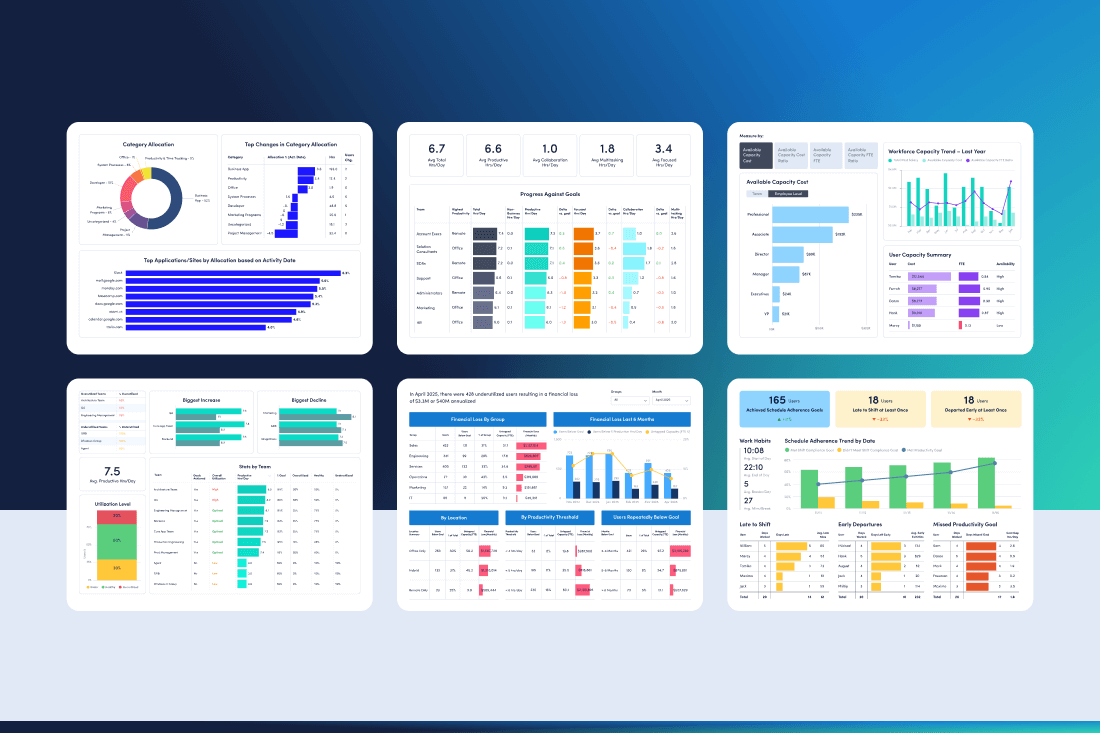Employers must be intentional about hybrid work and make the right decisions for their organizations. Learn how to make hybrid work successful for you.
Trying to build a successful hybrid work environment? You’re far from alone. More than half of employees with remote-capable jobs work in a hybrid setting, and their employers are all trying to find the right balance of control, autonomy and trust.
While hybrid models offer flexibility and collaboration benefiting both the organization and employees, it’s not always easy to implement successfully. In this post, we’ll share advice to help you get hybrid work right.
Challenges of hybrid work
Hybrid work is a great way to attract and retain top talent, and to help boost productivity. However, hybrid models also create challenges for employers and hybrid workers, such as:
- Ensuring equal access to tools and technology: It’s easy to verify access to the right technology (such as secure internet) when employees work in the office. But for remote workers? Not so much.
- Lack of visibility: Employees who work remotely are less visible to their leaders or managers and often miss out on day-to-day information sharing. Moreover, some managers don’t trust employees are doing work when they can’t see them at their desks.
- Poor company culture: It’s harder to build a strong company culture when individuals don’t see each other in person often.
- Uneven performance evaluation: When some employees report to the office and others work remotely, it’s tough to ensure fair performance reviews. In-office staff may get more face time (and thus more credit), while remote workers risk being overlooked or judged by output alone.
- Coordination overload: Managing hybrid schedules often leads to more meetings, check-ins and back-and-forth over calendars. This coordination burden drains time and energy, making agile decision-making harder and increasing frustration for both managers and team members.
Benefits of successfully implemented hybrid work
Hybrid work models offer substantial benefits when done right, including stronger employee engagement, better visibility into how work gets done and the ability to attract top talent while reducing overhead. The result is a healthier balance between flexibility, accountability and long-term resilience. For example, successful organizations experience:
- Enhanced productivity: An astounding 57% of employees report higher productivity levels when working remotely. More than half say they’re also more creative, and 49% are more likely to meet deadlines.
- Better efficiency: Workers who choose where and when they work concentrate without distractions and enjoy a more personalized environment.
- Improved work-life balance: Employees who get a say in their work schedules often have more options for managing their personal lives, including their mental health.
- Lower turnover: When employees are satisfied with their jobs, they’re less likely to look for a new role at another company.
- Greater recruiting options: Hybrid employers attract a wider pool of applicants, providing access to better candidates even if they aren’t always near a centralized office.
Strategies to make hybrid work successful
Every organization is different, and you may need to adapt how you implement hybrid work across teams or departments. However, these strategies are key in creating a successful hybrid work model for any organization.
1. Leverage hybrid workforce management software
Measuring how work is done — and how well — is key in making your hybrid model successful. If you don’t know if employees are more productive in the office or at home, how can you set a hybrid policy that makes sense? This is where ActivTrak’s hybrid workforce management software comes in. It shows you when, how and where employees work best, giving you tools to make decisions, implement an effective policy and measure the effects of your decisions on the workforce.
Location insights take this a step further by showing which environments support different types of work. You might find deep focus tasks happen more often at home, while collaboration thrives in the office. This clarity makes it easier to balance employee preferences with business needs.
Visibility also extends to employee well-being and workload distribution. By spotting signs of burnout, uneven workloads or long stretches of after-hours activity, you protect your team from fatigue while keeping productivity strong. This awareness helps managers step in with support, redistribute tasks or adjust expectations before small issues grow into larger problems.
2. Choose the right hybrid work model
Not every organization thrives under the same setup. The right hybrid model depends on your business goals, team dynamics and the type of work being done. A clear framework allows you to prevent confusion, set expectations and help employees plan their time more effectively.
Common hybrid models include:
- Mostly in-office: Employees spend the majority of their time onsite, with limited flexibility for remote days.
- Employee choice: Individuals decide where they work best on a given day, offering maximum flexibility.
- Time-based: Certain weeks or months are designated for in-office work, while others remain remote.
- Day-based: Specific days of the week are assigned for office presence, supporting regular collaboration.
- Mostly remote: Teams work offsite most of the time, using the office for occasional meetings or special projects.
3. Use digital-first tools
Most hybrid leaders understand the importance of technology. To ensure equal access for remote and in-office workers, digital-first formats are key. Moving all collaboration, communication and project management tools online ensures employees can access them whenever and wherever they need them.
But digital-first doesn’t mean tool overload. Many teams juggle overlapping apps for chat, file sharing and task management without realizing how much time — and budget — gets lost in the process. Understanding actual app usage helps you see which platforms drive productivity and which add little value.
With clear visibility, leaders make smarter choices about consolidating tools, streamlining workflows and cutting redundant subscriptions. The payoff is twofold: employees spend less time toggling between apps, and the business reduces unnecessary SaaS spend while keeping the essential tools that support hybrid work.
4. Prioritize clear communication
Clear communication drives organizational success, but it’s even more important for hybrid workplaces. From clear policies around who can work remotely (and when) to ongoing feedback about how your hybrid model affects your workers, ensure each element is communicated clearly. Employees who work remotely should never be surprised by news in-office employees got during a meeting.
To set the right foundation, focus on building a strong hybrid work policy. Include guidelines on work location expectations, schedules and availability, along with standards for meetings, communication channels and performance measurement. Outlines how the company supports collaboration, manages technology use and ensures equitable treatment between remote and office-based employees.
When you clearly document and consistently reinforce these expectations, employees know where they stand. The result is fewer misunderstandings, smoother coordination, and a culture of trust that helps hybrid work thrive.
5. Right-size your office space
Empty offices can be as distracting as bustling or over-filled ones. Ensure you have the right amount of space for the employees who need to come to the office. Provide quiet areas for team members who need to concentrate as well as collaborative spaces for impromptu meetings – just don’t forget to include remote workers with video conferencing tools.
Space utilization plays a big role here. Tracking how often teams use desks, meeting rooms and shared spaces helps you understand whether your office footprint is too large, too small or simply misaligned with employee needs. For example, if focus rooms sit empty while conference rooms are always booked, it’s a sign to rebalance your layout.
Right-sizing isn’t only about saving on real estate costs. It’s about creating a workplace that matches how employees actually work. A thoughtfully designed office supports productivity, reduces distractions and makes in-office time more purposeful — while ensuring hybrid employees feel equally included no matter where they’re located
6. Provide training and development opportunities
For hybrid employees who work remotely most of the time, it’s important to provide training and development opportunities so they can progress in their careers. Remote employees shouldn’t feel neglected or like they’re at a disadvantage for promotions compared to in-office counterparts. Ensure remote employees have avenues to grow their skills, such as online resources, training webinars, or even digital courses.
7. Be adaptable
Don’t expect your hybrid work model to run like a well-oiled machine immediately after implementing it. You’ll likely need to make tweaks, but the important thing is to update your policy as you uncover areas for improvement. By monitoring performance data and seeking feedback from your employees, you can adapt your hybrid model to make it more successful — and ensure it remains effective as conditions change in the future.
Use ActivTrak to make hybrid work successful in your organization
The hybrid work model presents many advantages for organizations that embrace it, but you must be ready to overcome the challenges. Harness the full potential of your hybrid workforce with insights and analytics from ActivTrak’s hybrid and remote workforce management software. Understand employee productivity, well-being and collaboration with data and easy-to-read dashboards. Contact our sales team today to learn how we can help make hybrid work successful for your organization.





